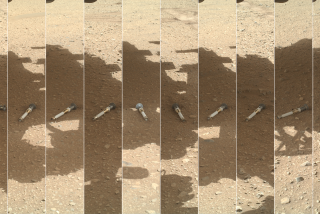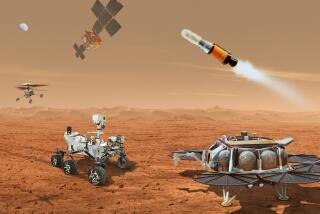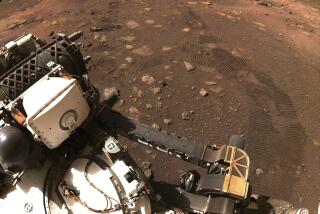OSIRIS-REx blasts off to sample asteroid Bennu
- Share via
It’s time to visit a fossil in space. Today at 7:05 p.m. Eastern, NASA’s OSIRIS-REx mission blasted off from Cape Canaveral on its two-year journey to the asteroid Bennu. Scientists hope to gather dust and gravel from the dark space rock and bring it back to Earth — marking the largest sample return since the Apollo missions, roughly half a century ago.
An hour after launch, after a series of rocket burns, OSIRIS-REx was flying free and traveling faster than 22,000 mph.
“This was superb to watch,” NASA Administrator Charles Bolden said as he congratulated the team assembled at Cape Canaveral.
When looking for fossils, paleontologists look down at the ground — but planetary scientists turn their eyes to the heavens. That’s because asteroids like Bennu contain primitive material that was never incorporated into planets and altered. Unlike the meteorites that hit the Earth and offer scientists a tantalizing but flawed look at these interplanetary building blocks, Bennu’s material is pristine, unaffected by atmospheres or contaminated by biology.
A handful of Bennu, brought back to Earth, could rewrite our understanding of the origins of own solar system — shedding light on how the planets formed, the nature of their contents and even on the origins of life on Earth.
Bennu is interesting for a number of reasons. For one thing, it’s dark, rich in organic material, which could help answer some questions about the solar system’s pre-biotic chemistry. It also orbits relatively close to Earth, and understanding the factors that influence its trajectory could help scientists predict which other near-Earth asteroids have a chance of hitting our planet.
The launch was only the start of a complex, multi-year journey. The spacecraft will fly by Earth next year; the planet’s gravity will help sling it toward the near-Earth asteroid. Once it arrives in August 2018, OSIRIS-REx will study the rock from orbit until July 2020, when it drops down to sample the loose material that scientists believe covers Bennu’s surface.
After that, it will still be years before the spacecraft returns with its precious cargo, which it will send to Earth in 2023 with the aid of a parachute.
“I plan to be in a rocking chair seven years from now, [watching] the capsule as it lands back in Utah,” Bolden told the team.
Follow @aminawrite on Twitter for more science news and “like” Los Angeles Times Science & Health on Facebook.
MORE IN SCIENCE
No, Apple’s new AirPods won’t give you cancer, experts say
Parasitologist bestows squirmy honor on his distant cousin, President Obama
Ethnic groups’ government influence and Internet access go hand in hand, study says
UPDATES:
6:10 p.m.: This story was updated to reflect that OSIRIS-REx launched successfully.
This article was originally published at 3:50 p.m.







